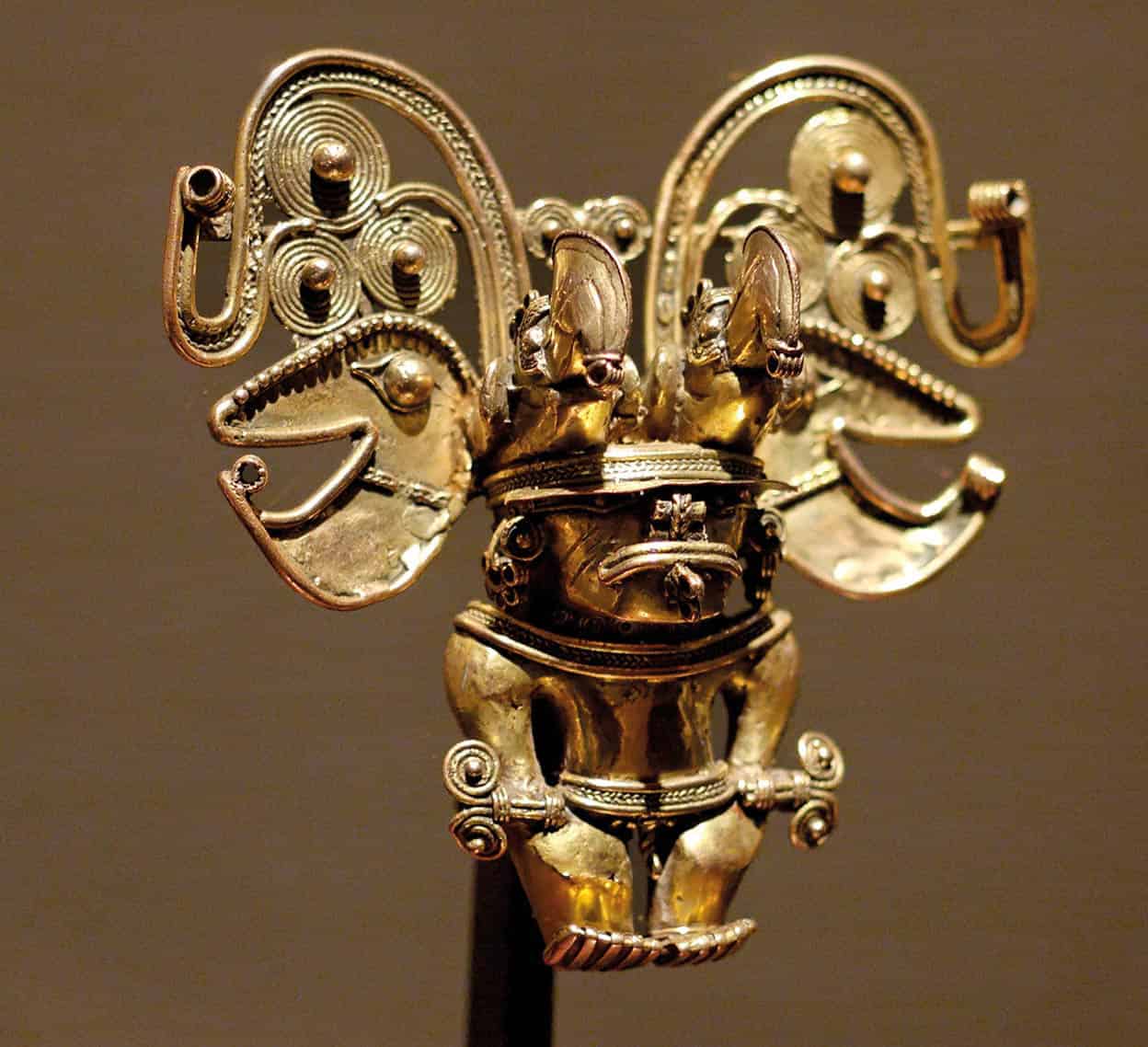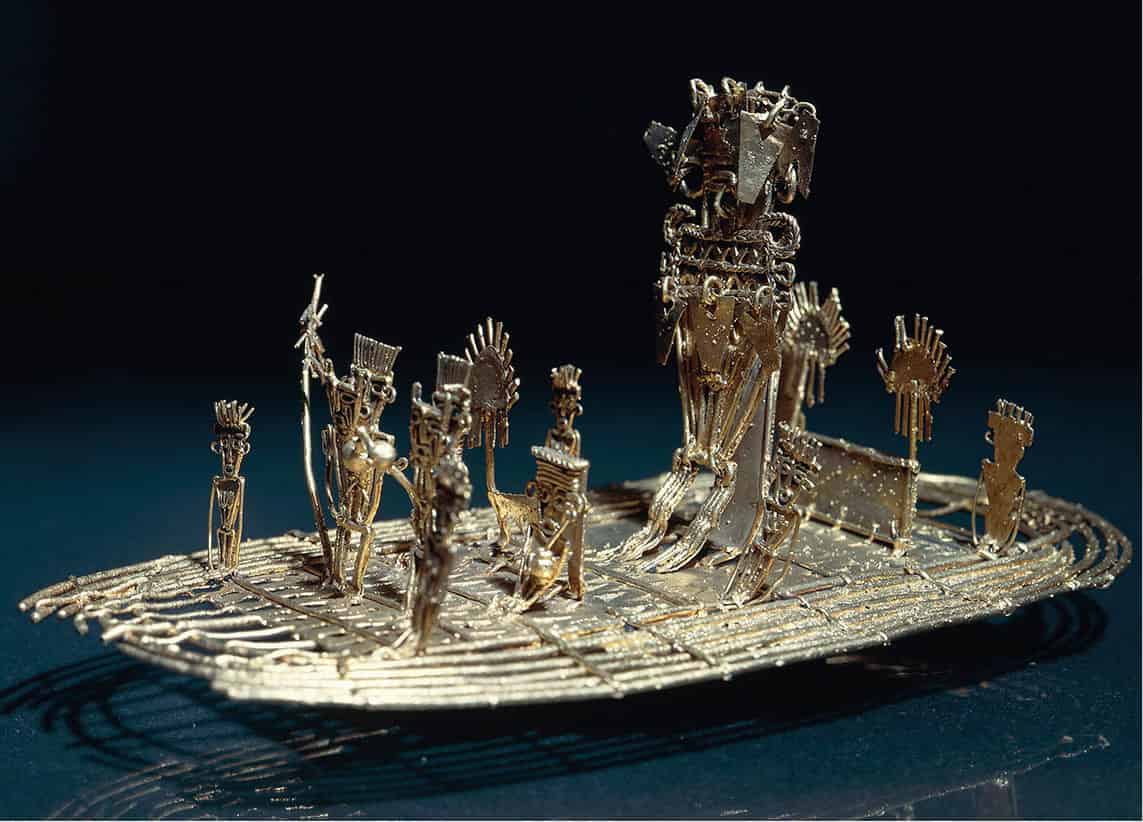Visitors to Colombia will find a country rich in indigenous heritage and ancient history. In stark contrast to many Western and European countries, much of Colombia’s indigenous population still thrive in various corners of the country. Their longevity perhaps isn’t so much the result of the wholesome, charitable relations between early occupiers and natives, but maybe more to do with the fact that when you exist in remote, inaccessible regions of mountainous or jungle terrain, it makes it harder for conquistadors to hunt you down and enslave or murder you.

Indigenous fertility and stability statue.
SuperStock
This well-preserved history makes it easier to gain an insight into not only the indigenous people of the last millennia, but the earliest inhabitants of the region too. As for the history of the land, many geologists believe Colombia was once part of Pangea, the last supercontinent, and formed when an area now known as South America broke away from present-day Africa some 200 million years ago.

Calima gold mask.
Shutterstock
Some archeologists believe that the first people arrived in Colombia around 45,000 BC, but most estimates place the timeline closer to 16,000 BC.
Hunter-gatherers
The first people arrived in Colombia during the late Pleistocene era. The archeological sites in Tibitó (located in the Andean plateaus north of Bogotá), El Totumo (in the Magadalena Valley), and Cudinamarca are generally regarded as the earliest sites of human occupation in the country. To put that into perspective, when these early humans appeared, mastodons still roamed the land and were a principal source of food.
The aboriginal peoples migrated from the Caribbean and Mesoamerica in the north and from the southern Andes and Amazon in the south. For thousands of years, various tribes lived and subsisted off the land, establishing permanent village settlements by 2000 BC. These tribes also traded with one another, and some of the oldest-known examples of pottery formed by indigenous hands date back to around 5000 BC.
From tribes to societies
Between 5000 and 1000 BC the hunter-gatherers shifted to an agrarian society, establishing permanent settlements and producing pottery. By the first millennium the tribes developed sophisticated political systems and social organizations. The Tairona, for example, who existed in the coastal Sierra Nevadas, were one of the most advanced of the early societies and developed a functional economy based on agriculture, commerce, and fishing. Like other advanced indigenous communities in Latin America, they also built aqueducts, roads, stairways, and public spaces.

Pendant of the Tairona people, depicting a shaman.
Public domain
Other indigenous tribes include the Muisca, whose first settlements date back to around 545 BC. They controlled the central Colombian Highlands. The mingling of ancient-indigenous peoples in Colombia’s surrounding was facilitated by the Muisca’s language, which was known as Chibcha. Linguists agree that Chibcha formed from a variety of now-extinct dialects that originated in regions as far north as Nicaragua and as far south as Ecuador. Certain Chibcha words still exist in modern Colombian Spanish, such as municipality names like Zapaquirá and Sogamoso. Even the root word of Bogotá is Chicbcha: Bacatá.
The original melting pot
Of all the ‘immigrant nations’ in the western hemisphere, Colombia might just be the first. Its early populations were comprised of indigenous groups from Mesoamerica and the Caribbean in the north, and the Andes and Amazon in the south. This created a rich diversity of cultures that benefited the country. And for the most part, these tribes co-existed peacefully and engaged in commerce, diplomacy, and redistribution with one another; lower-ranking chiefs, acting as intermediaries, would visit tribes in different regions and bring goods to exchange. This ensured indigenous groups had access to a variety of items no matter their geographical location in the country.

La Balsa de Eldorado (the Raft of El Dorado), from the Muisca period, on display at Bogotá’s Gold Museum.
Getty Images
Culture and customs
A confederation of Muisca states existed in the central Andean region of Colombia, with all of them being controlled in the Bogotá area by a zipa (ruler in the south), and a zaque (ruler in the north) in modern-day Tunja. These leaders did not wield absolute power, so unlike the Incas or Aztecs, the Muisca can’t be considered a kingdom or empire. Still, their leaders commanded great respect, and the zipa was even a de-facto intermediary between the heavens and earth. It was his responsibility to offer gifts to the Goddess Guatavita. The process involved the zipa covering himself with gold dust and taking a boat out to the middle of their most sacred body of water, Lake Guatavita, and throwing in gold trinkets. The lineage of individual zipa and zaque leaders can be traced back to the mid-to-late 15th century, just before the Spanish arrived in the country.
As for the economy, the Muisca’s was one of the strongest on the continent. This was due in no small part to Colombia’s rich abundance of gold and emeralds, which the Muisca mined copiously. They traded these precious stones and metals with one another, and this trade was the principal manner in which Muisca from different regions interacted. Their agrarian society utilized terraced farming methods in the highlands that grew, among other things, maize, potatoes, quinoa, coca, and cotton, for both consumption and trade. Certain sports were part of their rituals, and one typical Colombian game, tejo, a disc-tossing sport, is said to have its roots in Muisca culture. Muisca religion revolved around worship of the sun and moon, and priests were trained from childhood to lead religious ceremonies.
Native life on the coast
The Tairona people had their own chiefdoms back in the Sierra Nevada, Magdalena, and Guajira regions along the northern coast. The Tairona were the other dominant indigenous group in the country at the time, and they spoke their own version of Chibcha. Their chiefdoms date back to at least the 1st century AD, with some evidence suggesting they’d adapted to an agrarian society as far back as 1200 BC, maybe even earlier. Still, a boom in population growth turned the Tairona into a formidable society by the 11th century.
The religious beliefs of the Tairona were decidedly liberal, allowing for divorce and homosexuality, which would have been a shock for the new Catholic arrivals from Spain. The Taironas excelled at ceramics, and their craftsmanship went through various different phases from around 200 BC to 1650. However, like the Muisca, they were most renowned for their distinctive goldwork, some stunning examples of which can be seen at Bogatá’s Museo del Oro.
The artistic legacy of the indigenous peoples of Colombia is most pronounced in their goldwork. The Muisca, for example, created elaborate gold pendants, staffs, and transformational figures combining elements of man and animal.
Other peoples
The Tairona and Muisca may have been the largest of the indigenous groups, but there were other native tribes that flourished throughout the country. The Sinú, for example, established chiefdoms in the southern Caribbean Lowlands and throughout parts of Antioquia. They farmed maize and yucca in the wet marshlands, developing artificial mounds to facilitate the process. The Quimbaya people existed in certain areas of the Valle de Cauca and operated their society much the same way as the Muisca and Tairona. The Liles and Gorrones were also residents of the Valle de Cauca, and are classified as Calima, an umbrella term denoting indigenous groups who come from this region. These groups all developed economic systems based on agriculture, fishing, hunting, and trade.
All in all there are 102 indigenous groups in Colombia. Some still live in tribes to this day, living much the same as they did before Europeans arrived en masse with fever dreams of gold and a goal to conquer.